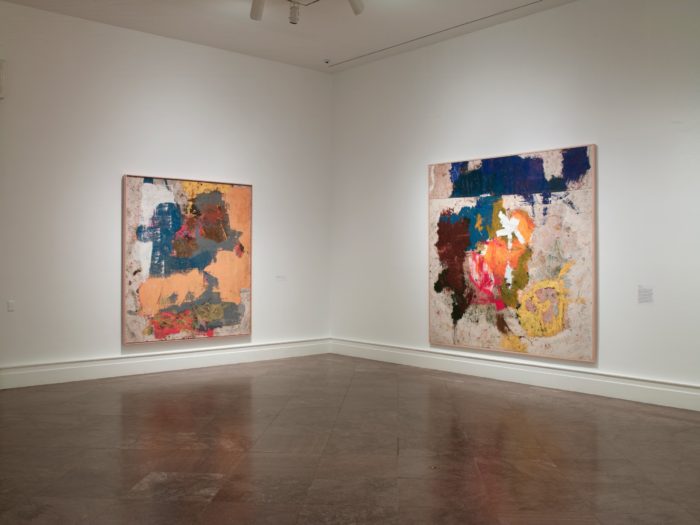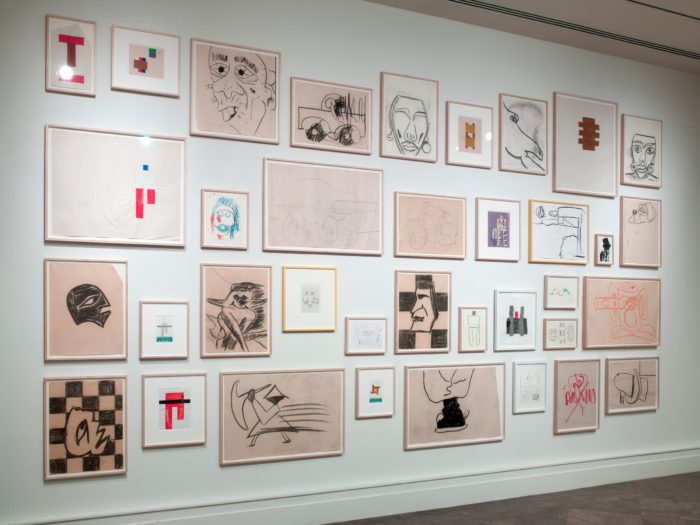The Albright-Knox Art Gallery in Buffalo, New York, is hosting the first US mid-career survey of artist Joe Bradley. For the occasion, the museum produced an outstanding catalogue, showcasing the many avenues that Joe’s work has taken over the years: from his modular paintings to his more expressionistic canvases. Here, we republish an excerpt from an interview between Joe Bradley and Carroll Dunham from the book.

JOE BRADLEY On a good day, yes. I do feel a momentum in my work. One thing leads to another, paintings suggest more paintings.
CD They have to feel a certain way in order to work for you?
JB I want them to feel like they have always been there, if you know what I mean.
CD The first time I came to your studio a few years ago you had all these canvases, very large things, spread over the floor, and I had an image of you walking around in your stocking feet dropping material onto large areas. The paintings seemed to accrue out of this activity, then at a certain point they’d go up on the wall and a cropping and editing process would happen that would determine the final presentation. Now, there are a lot of stretched canvases on the wall, taking up vertical pictorial space, like paintings. To me, it’s like you’re owning the fact that these things exist as paintings and that you’re working on them this way all the way through.
JB Yeah, I am attempting a more “proactive” approach [laughs]. Part of it is just practical. I was getting tired of crawling around on my hands and knees all day. I had a sense that I was hitting a wall with that body of work, that I was relying too heavily on accident. So changing tools—working with a brush on stretched canvas—was a way of pressing reset.


CD So, it’s really through those kinds of nuts and bolts—those choices and decisions about the procedures—that you’re going to use that start to make it look like something?
JB When I started making these paintings, I knew I wanted to work on stretched canvas and I knew I wanted to use a brush. I wanted large passages of color that extended to the edge of the painting. I wanted the painting to project into the room in a more assertive manner . . . all of these formal things, but I didn’t know what they would look like until I painted them. These “ideas” aren’t interesting or novel ideas. As for the scruffy quality, I do like the surface to feel fucked up. It’s like a kink. There’s a part of me that wishes I could just make beautiful paintings like Brice Marden or something . . . but I’m kind of an asshole [laughs] and that should be addressed, or at least acknowledged, in the work.
CD See, the thing that I find so interesting about what you’re up to is that I don’t think you’re illustrating a position. I think you’re finding it by doing it. And you could be this alleged asshole Joe Bradley, who kind of knows certain things are bullshit but also can’t help loving them. And you could attempt to illustrate that idea. I think that there are a lot of other artists who would take that approach. But your approach to me seems very different, and is much more about actually participating in what has to happen in order to even have anything to say about it, in order to even—it’s almost like the only thing you have to say about it are these things on the wall, what you make.
JB Right. That’s what makes an interview like this difficult. Or getting up and speaking in front of students or something. I’m not sure I have anything to say. I can kind of talk around it.
CD Well, we’re living through a period of time when there is meant to be a user’s manual for all of this stuff. There is an expectation that all of this can be translated into verbiage that would actually “explain” what you’re doing. Mostly what we’ve been talking about here is what it feels like to be an artist, how things get made, the fact that you have to show up every day in order to see a result. That’s very different from having ideas and then illustrating them.
JB I take issue with the notion that I am “expressing” myself at all. At least it doesn’t feel like that’s what’s happening. I’m more comfortable with the idea that I’m channeling, or facilitating, in some way.
Artwork © Joe Bradley. Joe Bradley at the Albright-Knox Art Gallery, Buffalo is on view June 24–October 1, 2017. Photos by Tom Loonan, courtesy Albright-Knox Art Gallery, Buffalo, New York
This interview is courtesy of Gagosian Gallery which is on their website here.
